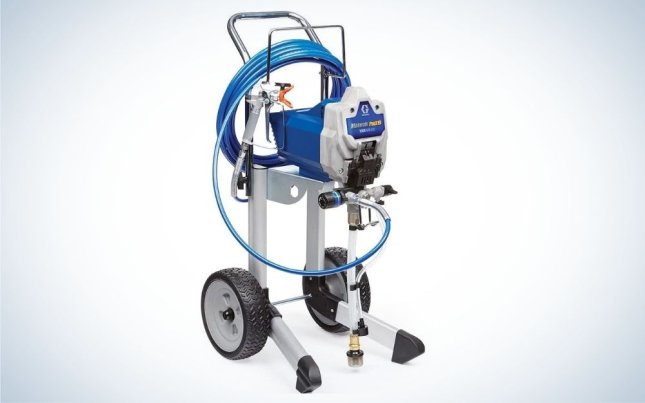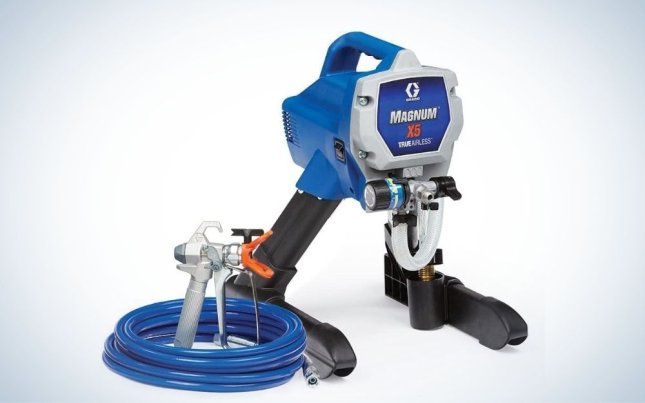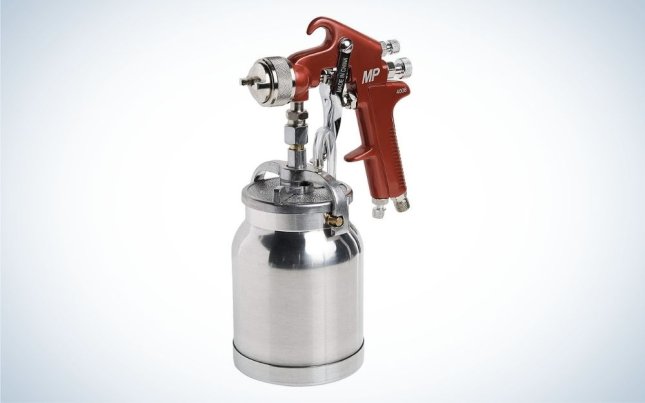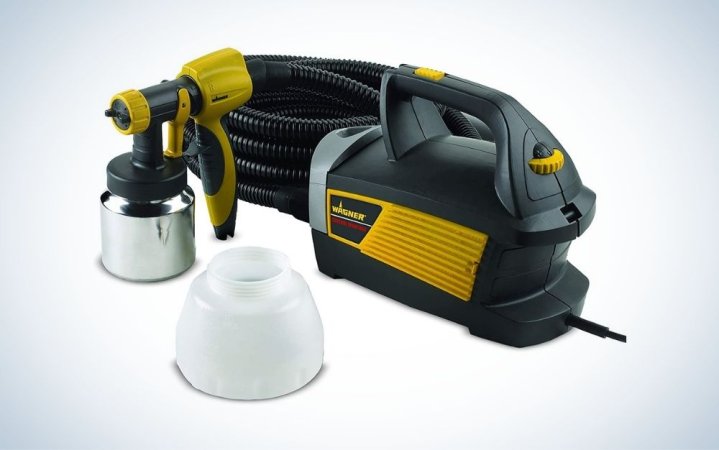We may earn revenue from the products available on this page and participate in affiliate programs. Learn more ›
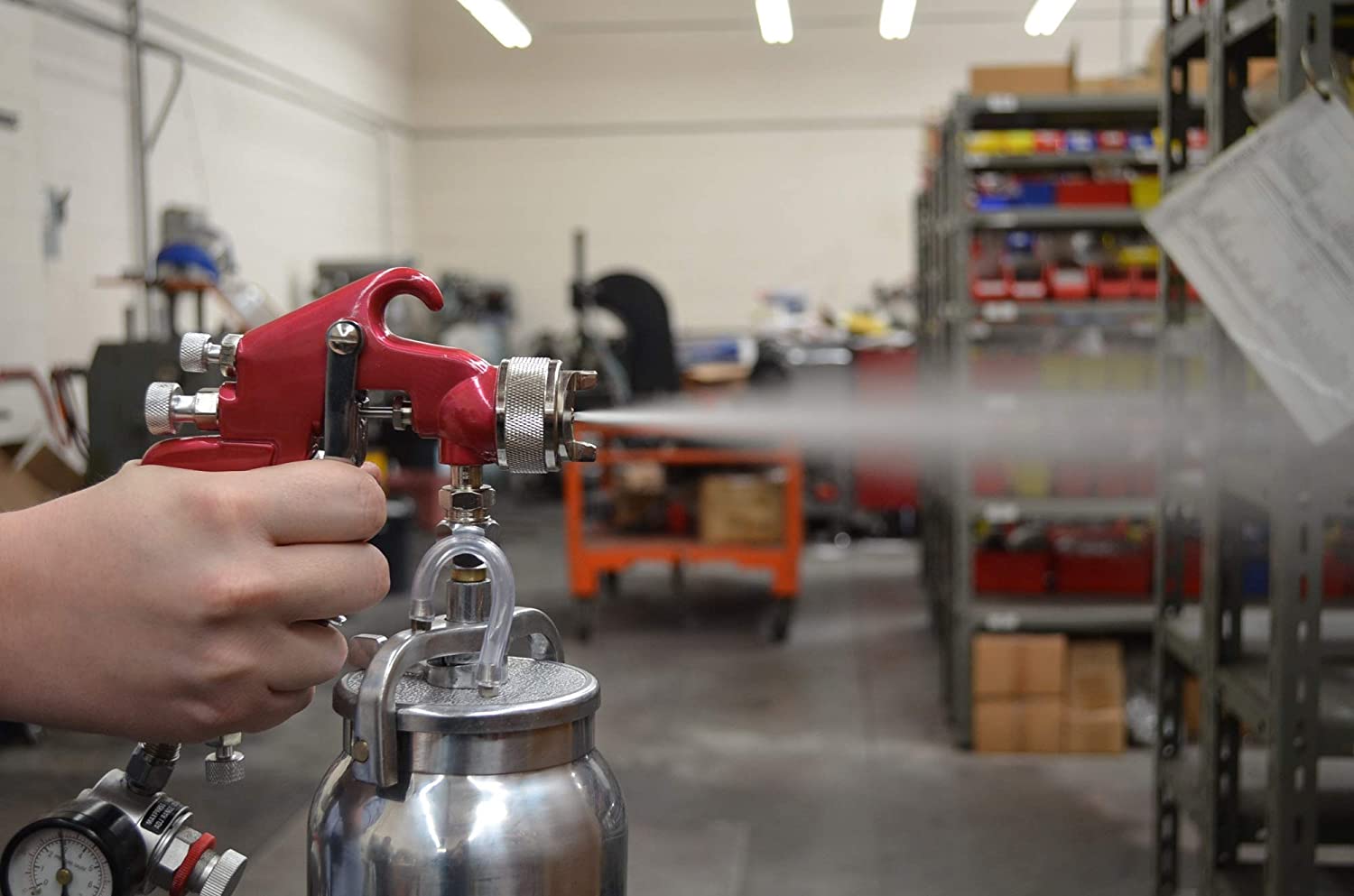
A professional paint spray gun will let you put aside brushes and rollers in favor of an efficient, effective, easy-to-use way to paint. These compact machines can help you tackle large paint jobs inside or outside the home, saving you time and undue joint pain. You can also use a paint gun to cover fences, furniture, and other objects with reasonably sized surface areas. While they may not be necessary for smaller tasks or rooms that are already filled to the brim with belongings (a paint sprayer can be pretty messy), the best paint spray guns will help you stay on schedule and make your recent home improvement renovations as easy as possible.
- Best airless: Graco Magnum X5 Airless Paint Sprayer
- Best HVLP: Wagner Spraytech Control Spray Max
- Best cart: Graco Magnum Prox19 Cart Paint Sprayer
- Best for your car: Wagner Spraytech MotoCoat Complete Sprayer
- Best budget: Astro Pneumatic Tool 4008 Spray Gun With Cup
The best paint spray guns: Reviews & Recommendations
Best airless: Graco Magnum X5 Airless Paint Sprayer
Complete Control
This Graco airless paint sprayer allows you to fully adjust the pressure settings for control over paint flow with a flexible suction tube that will enable you to pull paint directly from a 1-galloon to 5-gallon paint bucket. It can handle up to 125 gallons of paint per year and supports a hose that measures up to 75 feet. Best of all, this Graco paint sprayer comes with a power flush adapter that you can attach to an ordinary garden hose for an easy, efficient clean.
Best HVLP: Wagner Spraytech Control Spray Max
Designed For The Details
This HVLP paint spray gun from Wagner has a pressure control dial and material flow adjuster, so you can easily select your desired spray pattern for the perfect paint finish. The Wagner paint sprayer’s stationary base holds the heavier turbines and connects to a 20-foot hose with the lightweight spray unit attached. It comes with a 1.5-quart plastic cup and a 1-quart professional metal cup so you can choose what’s suitable for your particular project. This powerful Wagner paint sprayer works quickly and efficiently to paint cabinets, sidings, furniture, and more.
Best cart: Graco Magnum Prox19 Cart Paint Sprayer
Powerful And Precise
Another great Graco paint sprayer, this cart sprayer will do the trick for any large paint job. It has fully adjustable pressure settings, a PowerFlush adapter, and an InstaClean pump filter to reduce clogs. This Graco paint sprayer can spray up to 500 gallons of paint per year and support a hose reaching 150 feet for multistory projects. You can spray practically any type of paint, including unthinned latex, and the suction tube can connect directly to a 1-gallon to the 5-gallon paint bucket.
Best for your car: Wagner Spraytech MotoCoat Complete Sprayer
Refresh Your Ride
This HVLP paint spray gun was made for DIY auto projects. It can handle just about everything, from custom coatings for your truck bed to auto-finishing paints. This Wagner paint sprayer comes with two nozzles: the Detail Finish nozzle is designed for smooth, even surface coats, and the iSpray nozzle is meant for thick, textured coats for under beds and carriages. Volume flow, spray pattern, and spray width are all adjustable, plus the sprayer features a 39-foot hose, so you can easily maneuver around your vehicle.
Best budget: Astro Pneumatic Tool 4008 Spray Gun With Cup
Small But Mighty
This Astro spray gun has a 1.8-millimeter nozzle, adjustable fan, and 1-quart capacity dripless cup. It can spray a variety of paints and lacquers, including primers and topcoats, at various angles thanks to the anti-spill air feed line, which maintains proper suction at all times. This is a fantastic introductory paint spray gun; it even comes with detailed instructions specifically for beginners. Keep in mind this unit will require a separate air hose and a three-horsepower (3 hp) air compressor, double-check the specs on your other tools to make sure it is compatible.
Things to consider when picking the best paint spray guns to cover walls, ceilings, furniture, and more
Whether you’ve never used a paint gun before, or you’re just looking to try a new model, finding the best paint spray gun for your needs can be a bit tricky. Luckily, there are a few things you can do to prep before you spray that first coat. You’ll want to make sure you can safely use one of these efficient machines in your space. Unlike brushes and rollers, you won’t be able to control the mess a spray gun can make fully. It’s a good idea to put down drop cloths, tightly cover any pieces of furniture with plastic sheeting, and remove all the objects you can from the room before painting. Spray guns also use a lot of paint, which means it’s a good idea to stock up before beginning your process. Finally, invest in protective gear, such as goggles and a face mask or respirator, to ensure your safety. (Oh, and book in time and a place to flush the system after use.)
Once you’ve gone through all the necessary preparations, you’ll be ready to choose the best paint sprayer for your needs. There are three different types of paint sprayers: airless paint sprayers, which use high pressure to shoot thick paint out of the tip; HVLP (High Volume Low Pressure), which have a better transfer efficiency so you’ll get more paint on the area you’re aiming for rather than in the air; and, finally, air-assisted (or pneumatic), which are hooked up to air compressors and make for a great affordable option. Each one is designed for different projects and paint types.
You’ll also want to pay attention to the sprayer’s tips and spray patterns. For example, stains need a smaller tip and low pressure to be evenly distributed, while latex paints and primers thrive “under pressure” and require a wider tip. If you plan to use your paint spray gun for multiple projects, it’s a good idea to look for flexible tips or units that come with additional nozzles. Spray patterns describe the shape and direction the paint moves in when pushed out of the nozzle; many units have multiple pattern options, including horizontal, vertical, and round. This kind of flexibility will result in quick, complete coverage for numerous projects.
In order to determine which one of these models is right for you, consider the size and scale of your project. Think about where your priorities lie in terms of budget, paint volume, time, and style. If you’re still feeling a little lost, keep reading while we dive into each models’ specificities and features.
Related: You’ll nail your home improvement projects with these power tools.
Using thick latex paints?
If you’re setting out to redo the color on your living room walls or other large, flat surfaces, we suggest going with an airless paint spray gun. They work by utilizing high pressure to atomize the paint and then shoot it out through a specially designed tip, meaning the gun will never incorporate air into your paint. They are incredibly efficient, so you’ll be able to finish most projects within minutes. Plus, an airless sprayer is equipped to handle unthinned latex paints and primers popular for homes or businesses, meaning you’ll spend less time refiling the gun or restocking your chosen color. The high-pressure tip will deliver a seamless spray to coat your walls evenly, but they are prone to clogging because of the undiluted paint viscosity. Never fear; simply select a unit that has a reversible nozzle, so you can blow out the clog and get back to work.
Keep in mind, airless sprayers are subject to overspray because the paint shoots out of the gun with such intensity it can bounce back off of the surfaces. It’s a good idea to remove any furniture from the room you wish to paint and seal off any wall trimmings or moldings you want to keep clean. You’ll also want to take additional safety precautions: ensure proper ventilation, keep your hands away from the tip of the gun, and wear protective goggles.
Working on furniture and other smaller projects?
If you want a paint spray gun to help you coat furniture items like tables, buffets, credenzas, and more, we recommend going with an HVLP model.
High volume (the HV) means an increased air volume to carry the paint to the tip of the spray gun, so you’ll have more paint landing on the surface in a concentrated manner. This results in less waste when it comes to paint particles and fewer trips to the hardware store to re-up your supply. Low pressure (the LP) will reduce overspray and increase control, with a narrow nozzle that’s perfect for getting full coverage in cracks and crevices.
HVLP nozzles can help you paint surface areas as small as bicycles, chair legs, or door frames while keeping surrounding furniture clean (though it never hurts to add a tarp or two, just in case). These spray guns are great for pretty much any project. You can use them to paint your walls too; however, HVLP sprayers will take more time to cover large areas than an airless gun, so prepare accordingly. They are also not equipped to handle thick latex paints; HVLPs are best for oil-based or thinned latex paints, varnishes, and stains.
Need to cover a large area like the exterior of your home?
Are you planning on giving your entire home a fresh coat of paint? Or maybe you have a guest house in the back that could use a little re-touching? If this is the case, think about investing in a cart. While other paint spray guns, like the ones mentioned above, are suitable for projects of various sizes, a cart is the best way to eliminate refills so you can make the most of your time. Other handheld models can hold roughly 1 quart of paint, while a cart allows you to connect the spray tube directly to a paint bucket ranging in size. Carts will also allow you to connect extra-long hoses, so you don’t have to lug the unit up and down stairs or around the perimeter of your home. And wheels make moving them around a piece of cake. Plus, the pumps on cart models can typically handle well over 100 gallons of paint per year, so you won’t have to stop your project short for any replacement parts.
A cart paint sprayer is generally more expensive than other handheld models, so we recommend investing in one if you foresee many/multiple renovations or paint jobs in your future. Or if the project is just too massive for a smaller paint spray gun to handle. They are a great tool to have around if your once DIY projects start turning into a new, fully-fledged home renovation business.
Are you planning on painting your car?
Giving your car a fresh paint job can go a long way when it comes to upgrading your ride. While it’s not the easiest task, a paint spray gun can give your car a new coat without taking it into the shop. In order to do this, you’ll want to grab a handheld paint sprayer that is easy to hold and designed with detail in mind.
An HVLP gun will give you the sleek, smooth finish your car deserves, especially if it comes with a detailing nozzle for additional clean coverage. For heavier primers and surfacers, use a nozzle between 1.7 and 2.2 millimeters. Basecoats and sealers need 1.4- to 1.6-millimeter openings; clearcoats need a 1.3- to 1.7-millimeter nozzle. It’s essential to use the appropriate nozzle to avoid annoying clogs and ensure you get a texture-free coat without any orange peel, which is a pitted effect caused by low-quality paint spray guns and incorrect tip sizing. Additionally, double-check your spray gun’s specs to make sure it can handle lacquers and urethane paint. (We do not recommend using acrylic enamel paint in a spray gun, especially for your car; leave that one to the professionals.)
Besides buying the right spray gun, there are a few other tips and tricks to make painting your car a little easier. Instead of moving the gun from your wrist, make sure you paint with your entire arm, moving from the shoulder so that the sprayer remains perpendicular to the vehicle at all times. This is the best way to get an even finish. Additionally, you want to make sure you seal off everything you do not want to paint: windows, windshields, handles, etc. Even though an HVLP gun does not produce as much overspray as other models, there will still be some transference, and you don’t need to waste your time scrubbing paint off your windows.
Do I need to break the bank to find an excellent paint spray gun?
If you aren’t planning on using your new paint spray gun for multiple projects and you just need one great gun for something simple, you certainly don’t need to spend a lot to get the results you require. When looking for a more affordable model, go with a pneumatic gun. These units tend to be significantly less expensive than airless or HVLP models and will work just as well for smaller paint jobs. Pneumatic sprayers only need to be hooked up to an air compressor, and they are good to go. They do tend to have quite a bit more overspray, so just make sure you protect any surrounding furniture, walls, etc. Pneumatic sprayers work best with thinned or oil-based paints.
FAQs
Technically, yes, a paint sprayer uses, on average, around 33-percent more paint than a roller or other painting tool. It’s airless sprayers that use the most, while HVLP guns use about 20-percent more than your average roller. Gravity guns that rely on high pressure can need about 1.5 cups of paints for every one cup you need for a more analog method.
In general, it is not recommended you leave any paint in your sprayer overnight. If you absolutely must, make sure you depressurize the sprayer and place the gun and intake tube in a bucket of water. Suppose the paint dries up inside the nozzle or canister. In that case, you’ll find yourself in a stressful cleaning situation that may require professional assistance to clear up or, even worse, cause permanent damage.
Yes, you can run water through a paint sprayer. This is the best way to clean the unit after using materials like latex-based paint. You can use paint thinner to clean up after oil-based paints and lacquers. It is recommended to clean out your paint sprayer after every use.
Related: Notice lots of odd jobs that need doing? Here are the best home maintenance tools.
The final word on the best paint spray guns
- Best airless: Graco Magnum X5 Airless Paint Sprayer
- Best HVLP: Wagner Spraytech Control Spray Max
- Best cart: Graco Magnum Prox19 Cart Paint Sprayer
- Best for your car: Wagner Spraytech MotoCoat Complete Sprayer
- Best budget: Astro Pneumatic Tool 4008 Spray Gun With Cup
Whether you’re starting your first DIY project or you are home improvement royalty, investing in a new paint spray gun is never a bad idea. The time you’ll save by getting rid of brushes and rollers will leave your schedule wide open, so you can tackle everything else on your to-do list. The best paint spray gun will be particularly formatted to fit the surfaces you are covering and the paint you are using without any extra hassle. Once you find a paint gun you love, we wouldn’t be surprised if suddenly every wall in your home just “needs” a new coat.
